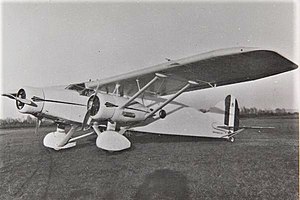Caproni Ca.133
| Caproni Ca.133 | |
|---|---|
 |
|
| Role | Transport/Light bomber |
| Manufacturer | Caproni |
| First flight | 1934 |
| Introduction | 1935 |
| Retired | 1948 |
| Primary users |
Regia Aeronautica Ala Littoria |
| Number built | 505 + 1 prototype |
The Caproni Ca.133 was a three-engined transport/bomber aircraft used by the Italian Regia Aeronautica from the Second Italo-Abyssinian War until World War II.
Originally developed as a civilian airliner and successor to the Ca.101, the Ca.133 prototype first flew in December 1934, and production began in 1935. The military versions of the aircraft were used as transports and light bombers and saw action on all fronts.
A stretched transport version of the aircraft was produced as the Caproni Ca.148.
Designed by ingegnere Rodolfo Verduzio, the Caproni 133 was aerodynamically and structurally an improved Ca.101. Like its predecessor, the Ca.101, was a robust and inexpensive aircraft, designed to be easily maintained in difficult conditions and economical to operate. It had a welded steel-tube structure, mixed construction, with metal and fabric covering, main wheel spats, flaps and modified tail surfaces.
The wing was high-mounted, roughly elliptical, and made of wood and steel. The undercarriage was spatted and fixed. The aircraft was powered by three engines, one in the nose, and one under each wing mounted in faired nacelles, with NACA cowlings, supported by steel tubes.
The civil version could accommodate up to 16 passengers. It was used by Ala Littoria. The military version was widely used by Regia Aeronautica, mostly in Italian East Africa. As a bomber it incorporated two small internal bomb bays where it could hold up to 500 kg (1,100 lb). Larger ordnance could be mounted externally. It was armed with four 7.7 mm (.303 in) Breda-SAFAT machine guns, one dorsal, one ventral, and two lateral. Bomber aircraft operated as military transports, redesignated Ca 133T, had their interiors modified to accommodate 18 fully equipped soldiers.
...
Wikipedia
